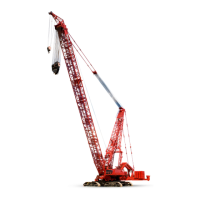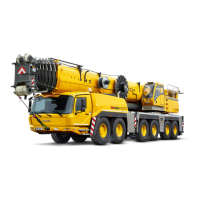Manitowoc Published 10-01-2012, Control # 045-08 1-57
777 SERVICE MANUAL INTRODUCTION
1
CRANE SETUP SYSTEMS
See Figure 1-40 for following procedures.
With the crane setup operating mode selected and
confirmed at the crane mode selector, the PC activates the
remote controller for the raise and lower functions of the
boom hoist cylinders used during assembly and
disassembly.
The crane setup hydraulic cylinder circuits are controlled
through the use of one mobile-type control valve called the
lower accessory valve. The control valve has parallel
operating circuits and contains relief valve that is preset for
3,100 psi (214 bar). The lower accessory valve controls
carbody jacking cylinders and crawler lock pin cylinders.
These valve sections are activated by spring-centered hand
levers that return to a neutral position when not activated.
The output flow from the crane setup pump section of
tandem gear accessory pump is discharged to tank through
pilot-operated check valve when all sections of the control
valve are not being used. The oil then flows through check
valve through system return filter, into the boom hoist hot oil
shuttle valve, ensuring proper charge pressure for the boom
hoist circuit.
When actuating a valve section of the lower accessory valve,
the supply flow passages are blocked, stopping oil flow to
check valve. The oil within the pilot cavity of valve exhausts
to tank through bleed-off orifice and permits the check valve
to close. The output from the setup pump section of
accessory pump is no longer discharged to tank through the
hot oil shuttle valve but supplied to the function of the lower
accessory valve.
Carbody Jacking System
The following description is for one carbody jacking cylinder.
Operation of one or all four cylinders is identical; and all
cylinders can be operated at the same time if the crane is in a
level position.
Each carbody jacking cylinder has a counterbalance valve at
the cylinder port. These valves ensure smooth control when
raising or lowering the crane; and lock the carbody jacking
cylinders in place when not in use, in the event of a hydraulic
line breakage, or during the occurrence of accidental or
unauthorized operation of the control valve when the crane’s
power system is shut down. In addition, the counterbalance
valves provide relief protection for the cylinders and shield
them from unforeseen mechanical overloading.
The accessory valve used in this circuit contains a motor
spool (both cylinder ports and tank port of the valve spool
section are connected in the center or neutral position). This
spool selection prevents premature opening of the
counterbalance valves.
Jacking Cylinder Extend
See Figure 1-42 for following procedures.
When a carbody jacking cylinder control valve handle is held
in the extend position, moving the lever downward on lower
accessory valve, the valve section shifts to direct oil flow
from the setup pump section of accessory pump into relief
valve (preset to 3,100 psi / 214 bar) section of lower
accessory valve. Note the system pump flow pressure is
limited by relief valve in system disable valve which is preset
to approximately 2,700 psi (186 bar).
The oil exits the desired function valve section of lower
accessory valve into counterbalance valve. The oil then
enters the head end of carbody jacking cylinder, extending
the cylinder to lift the carbody.
Oil returning to tank from the rod end of the carbody jacking
cylinder is blocked by the free-flow poppet (check valve)
section of counterbalance valve and flows through the
valve’s load restraining section which is preset to 3,500 psi
(241 bar). The counterbalance valve serves as a
deceleration control and functions with a 3:1 pilot ratio of the
pressure setting, permitting the valve to open when the
pressure in the rod end of the cylinder is approximately 1,170
psi (81 bar). The restraining section of counterbalance valve
opens, controlling the oil flow out of the carbody jacking
cylinder. The oil then flows through the free-flow poppet
(check valve) section of flow control valve before proceeding
to lower accessory valve. The oil leaving the lower accessory
valve returns to tank.
Jacking Cylinder Neutral
See Figure 1-42 for following procedures.
When a carbody jacking cylinder control valve handle is not
activated, it assumes a neutral position and oil flow passage
to carbody jacking cylinder is blocked. In this position, the
valve section cylinder ports are connected to tank which
prevents inline pressure from opening counterbalance valve.
The carbody load is essentially held in position by the
counterbalance valve.

